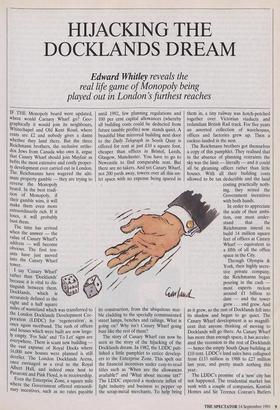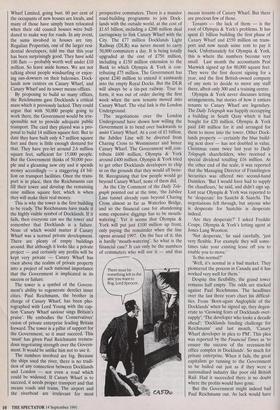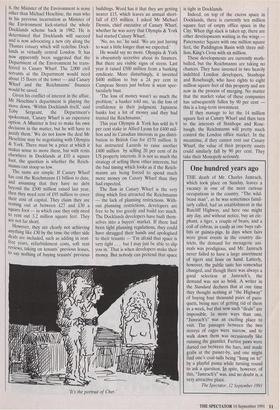HIJACKING THE DOCKLANDS DREAM
Edward Whitley reveals the
real life game of Monopoly being played out in London's furthest reaches
IF THE Monopoly board were updated, where would Carnary Wharf go? Geo- graphically it would join its neighbours, Whitechapel and Old Kent Road, where rents are £2 and nobody gives a damn whether they land there. But the three Reichmann brothers, the reclusive ortho- dox Jews from Canada who own it, argue that Canary Wharf should join Mayfair as befits the most extensive and costly proper- ty development ever carried out in London.
The time has arrived when the answer — the value of Canary Wharfs address — will become obvious. The first ten- ants have just moved into the Canary Wharf tower.
I say 'Canary Wharf rather than `Docklands' because it is vital to dis- tinguish between them. Docklands, which is accurately defined as the eight and a half square miles of wasteland which was transferred to the London Docklands Development Cor- poration (LDDC) for 'regeneration', is once again moribund. The rush of offices and houses which were built are now large- ly empty. `For Sale' and 'To Let' signs are everywhere. There is scant new building the vast expanse of Royal Docks where 16,000 new houses were planned is still derelict. The London Docklands Arena, once envisaged as a rival to the Royal Albert Hall, and indeed once host to Pavarotti and Pink Floyd, is in receivership. Even the Enterprise Zone, a square mile where the Government offered extraordi- nary incentives, such as no rates payable until 1992, few planning regulations and 100 per cent capital allowances (whereby all building costs could be deducted from future taxable profits) now stands quiet. A beautiful blue mirrored building next door to the Daily Telegraph in South Quay is offered for rent at just £10 a square foot, cheaper than offices in Bristol, Leeds, Glasgow, Manchester. You have to go to Newcastle to find comparable rent. But there are no takers. And yet Canary Wharf, not 200 yards away, towers over all this un- let space with no expense being spared in its construction, from the ubiquitous mar- ble cladding to the specially commissioned street lamps, benches and railings. What is going on? Why isn't Canary Wharf going bust like the rest of them?
The story of Canary Wharf can now be seen as the story of the hijacking of the Docklands dream. In 1982, the LDDC pub- lished a little pamphlet to entice develop- ers to the Enterprise Zone. This spelt out the financial incentives under easy-to-read titles such as 'When are the allowances available?' and 'What about income tax?' The LDDC expected a moderate influx of light industry and business to pepper up the scrap-metal merchants. To help bring them in, a tiny railway was hotch-potched together over Victorian viaducts and redundant British Rail track. For five years an assorted collection of warehouses, offices and factories grew up. Then a cuckoo landed in the nest.
The Reichmann brothers got themselves a copy of this pamphlet. They realised that in the absence of planning restraints the sky was the limit — literally — and it could all be gleaming offices rather than little houses. With all their building costs allowed to be tax deductible and the land costing practically noth- ing, they seized the Government incentives with both hands.
In order to appreciate the scale of their ambi- tion, one must under- stand that the Reichmanns intend to build 14 million square feet of offices at Canary Wharf — equivalent to a fifth of all the office space in the City.
ated the recession in the rest of Docklands — hence the empty South Quay building at £10 rent. LDDC's land sales have collapsed from £133 million in 1988 to £27 million last year, and pretty much nothing this year.
The LDDC's promise of a 'new' city has not happened. The residential market has sunk with a couple of companies, Kentish Homes and Sir Terence Conran's Butlers Wharf Limited, going bust. 60 per cent of the occupants of new houses are locals, and many of those have simply been relocated when their old council houses were bull- dozed to make way for roads. In any event, the sums involved in houses are tiny. Regalian Properties, one of the larger resi- dential developers, told me that this year has been surprisingly good. They have sold 100 flats — probably worth well under £10 million. So leave aside homes. We are not talking about people windsurfing or enjoy- ing sun-downers on their balconies. Dock- lands now centres on Canary Wharf, and Canary Wharf and its tower means offices.
By proposing to build so many offices, the Reichmanns gave Docklands a critical mass which it previously lacked. They could argue that with 50,000 people going to work there, the Government would be irre- sponsible not to provide adequate public transport. The card they played was a pro- posal to build 14 million square feet. But to date they have built only 4.7 million square feet and there is little enough demand for that. They have pre-let around 2.6 million square feet, sufficient for 15,000 people. But the Government thinks of 50,000 peo- ple and a gleaming new city and it spends money accordingly — a staggering £4 bil- lion on transport facilities. Once the trans- port is in place, then the Reichmanns can fill their tower and develop the remaining nine million square feet, which is when they will make their real money.
This is why the tower is the first building to be ready. The Reichmanns have made it the highly visible symbol of Docklands. If it fails, then everyone can see the tower and remember that Docklands is a failure. None of which would matter if Canary Wharf was a normal private development. There are plenty of empty buildings around. But although it looks like a private project — and certainly any profits will be kept very private — Canary Wharf has risen above the realms of private property into a project of such national importance that the Government is implicated in its success or failure.
The tower is a symbol of the Govern- ment's ability to regenerate derelict inner cities. Paul Reichmann, the brother in charge of Canary Wharf, has been pho- tographed with Lord Young with the cap- tion 'Canary Wharf saviour sings Britain's praise'. He embodies the Conservatives' vision of private enterprise leading Britain forward. The tower is a pillar of support for the Government, so it must succeed. This `must' has given Paul Reichmann tremen- dous negotiating strength over the Govern- ment. It would be unlike him not to use it.
The numbers involved are big. Because the ships used the river, there is no tradi- tion of any connection between Docklands and London — not even a road which could be widened. If Canary Wharf is to succeed, it needs proper transport and that means roads and trains. The airport and the riverboat are irrelevant for most
prospective commuters. There is a massive road-building programme to join Dock- lands-with the outside world, at the cost of £1.65 billion, including a £200 million dual carriageway to link Canary Wharf with the City. The £77 million Docklands Light Railway (DLR) was never meant to carry 50,000 commuters a day. It is being totally upgraded at the cost of £750 million, including a £150 million extension to the Bank to which Olympia & York is con- tributing £75 million. The Government has spent £240 million to extend it eastwards into the empty Royal Docks. But the DLR will always be a tin-pot railway. True to form, it was out of order during the first week when the new tenants moved into Canary Wharf. The vital link is the London Underground.
The negotiations over the London Underground have shown how willing the Government is to bend over backwards to assist Canary Wharf. At a cost of £1 billion, the Jubilee Line will be diverted from Charing Cross to Westminster and hence Canary Wharf. The Government will,con- tribute £600 million, Olympia & York around £400 million. Olympia & York tried to get other Docklands developers to chip in on the grounds that they would all bene- fit. Recognising that few people would go beyond Canary Wharf, none of them did.
As the City Comment of the Daily Tele- graph pointed out at the time, 'the Jubilee Line tunnel already runs beyond Charing Cross almost as far as Waterloo Bridge, and so the financial case for abandoning some expensive diggings has to be mouth- watering.' Yet it seems that Olympia & York will put just £100 million up front, only paying the remainder when the line opens around 1997. On the face of it, this is hardly 'mouth-watering'. So what is the financial case? It can only be the numbers of commuters who will use it — and that means tenants of Canary Wharf. But there are precious few of those.
Tenants — the lack of them — is the root of Olympia & York's problems. It has spent £1 billion building the first phase of Canary Wharf and £550 million on trans- port and now needs some rent to pay it back. Unfortunately for Olympia & York, this is where the numbers become very small. Last month the accountants Peat Marwick signed up for 80,000 square feet. They were the first decent signing for a year, and the first British-owned company of any note to decide to move any staff there, albeit only 300 and a training centre.
Olympia & York never discusses letting arrangements, but stories of how it entices tenants to Canary Wharf are legendary. The Daily Telegraph was happily occcupying a building in South Quay which it had bought for £20 million. Olympia & York paid £40 million for it and arranged for them to move into the tower. Other Dock- lands property — certainly the blue build- ing next door — has not doubled in value. Christmas came twice last year to Daily Telegraph shareholders, who received a special dividend totalling £16 million. At the other end of the scale, it was reported that the Managing Director of Framlington Securities was offered two second-hand Daimlers. But I would have had to supply the chauffeurs,' he said, and didn't sign up. Last year Olympia & York was reported to be 'desperate' for Saatchi & Saatchi. The negotiations fell through, but anyone who is desperate for Saatchis is desperate indeed.
`Are they desperate?' I asked Freddie Coupe, Olympia & York's letting agent at Jones Lang Wootton.
`Not desperate,' he said carefully, 'just very flexible. For example they will some- times take your existing lease off you to enable you to move.'
`Is this normal?'
`Well, it's normal in a bad market. They pioneered the process in Canada and it has worked very well for them.'
Despite this flexibility, the grand tower remains half empty. The odds are stacked against Paul Reichmann. The headlines over the last three years chart his difficul- ties. From 'Born-again Anglophile of the Docklands' when he signed up, they degen- erate to 'Growing fears of Docklands over- supply'; 'The developer who looks a decade ahead'; 'Docklands funding challenge for Reichmann' and last month, 'Canary Wharf developer in plea to PM'. This plea was reported by the Financial Times as `to ensure the success of the recession-hit office complex in Docklands'. So much for private enterprise. When it fails, the great capitalists go running to the Government to be bailed out just as if they were a nationalised industry like poor old British Rail. Had it succeeded there is no doubt where the profits would have gone.
But the Government might indeed bail Paul Reichmann out. As luck would have it, the Minister of the Environment is none other than Michael Heseltine, the man who in his previous incarnation as Minister of the Environment kick-started the whole Docklands scheme back in 1982. He is determined that Docklands will succeed and is now advocating a new city along the Thames estuary which will redefine Dock- lands as virtually central London. It has now apparently been suggested that the Department of the Environment be trans- ferred to Canary Wharf. The 2,000 civil servants at the Department would need about 15 floors of the tower — and Canary Wharf and the Reichmanns' finances would be saved.
Given his conflict of interest in the affair, Mr Heseltine's department is playing the move down. 'Within Docklands itself,' said Toby Sergeant, the Department's spokesman, 'Canary Wharf is an expensive option. A Minister is free to make his own decisions in the matter, but he will have to justify them.' We do not know the deal Mr Heseltine may be negotiating with Olympia & York. There must be a price at which it makes sense to move there, but with rents elsewhere in Docklands at £10 a square foot, the question is whether the Reich- manns can stoop so low. The sums are simple. If Canary Wharf has cost the Reichmanns £1 billion to date, and assuming that they have no debt beyond the £500 million raised last year, then they need rent of £95 million to cover their cost of capital. They claim they are renting out at between £27 and £30 a square foot — in which case they only need to rent out 3.2 million square feet. They are not far short.
However, they are clearly not achieving anything like £30 by the time the other side deals are included, such as adding in rent- free years, refurbishment costs, soft rent reviews, taking on tenants' previous leases, to say nothing of buying tenants' previous buildings. Word has it that they are getting nearer £15, which leaves an annual short- fall of £55 million. I asked Mr Michael Dennis, chief executive of Canary Wharf, whether he was sorry that Olympia & York had started Canary Wharf.
`No, no, no,' he said. 'We are just having to wait a little longer than we expected.'
He would say no more. Olympia & York is obsessively secretive about its finances. But there are visible signs of stress. Last year it raised £500 million from a banking syndicate. More disturbingly, it invested $400 million to buy a 24 per cent in Campeau Stores just before it went spec- tacularly bust.
`The loss of money wasn't so much the problem,' a banker told me, 'as the loss of confidence in their judgment. Japanese banks lost a lot of money and they had trusted the Reichmanns.'
This year Olympia & York has sold its 9 per cent stake in Allied Lyons for £400 mil- lion and its Canadian interests in gas distri- bution to British Gas for £570 million. It has instructed Lazards to raise another £400 million by selling 20 per cent of its US property interests. It is not so much the strategy of selling these other interests, but the bad timing which looks as if the Reich- manns are being forced to spend much more money on Canary Wharf than they had expected.
The flaw in Canary Wharf is the very thing which first attracted the Reichmanns — the lack of planning restrictions. With- out planning restrictions, developers are free to be too greedy and build too much. The Docklands developers have built them- selves into a buyers' market. If there had been tight planning regulations, they could have shrugged their hands and apologised to their tenants — 'I'm afraid that space is very tight . . . but I may just be able to slip you in.' That is when developers make their money. But nobody can pretend that space it's the portrait of Cher.' is tight in Docklands.
Indeed, on top of the excess space in Docklands, there is currently ten million square feet of empty office space in the City. When that slack is taken up, there are other developments waiting in the wings Paternoster Square with one million square feet, the Paddington Basin with three mil- lion, King's Cross with six million.
These developments are currently moth- balled, but the Reichmanns are taking no chances. They have invested in two heavily indebted London developers, Stanhope and Rosehaugh, who have rights to eight million square feet of this property and are now in the process of merging. No matter that the market value of these companies has subsequently fallen by 90 per cent this is a long-term investment.
If they manage to let the 14 million square feet at Canary Wharf and then turn to the interests of Stanhope and Rose- haugh, the Reichmanns will pretty much control the London office market. In the meantime, if they cannot rent out Canary Wharf, the value of their property assets could similarly fall by 90 per cent. They take their Monopoly seriously.




















































 Previous page
Previous page